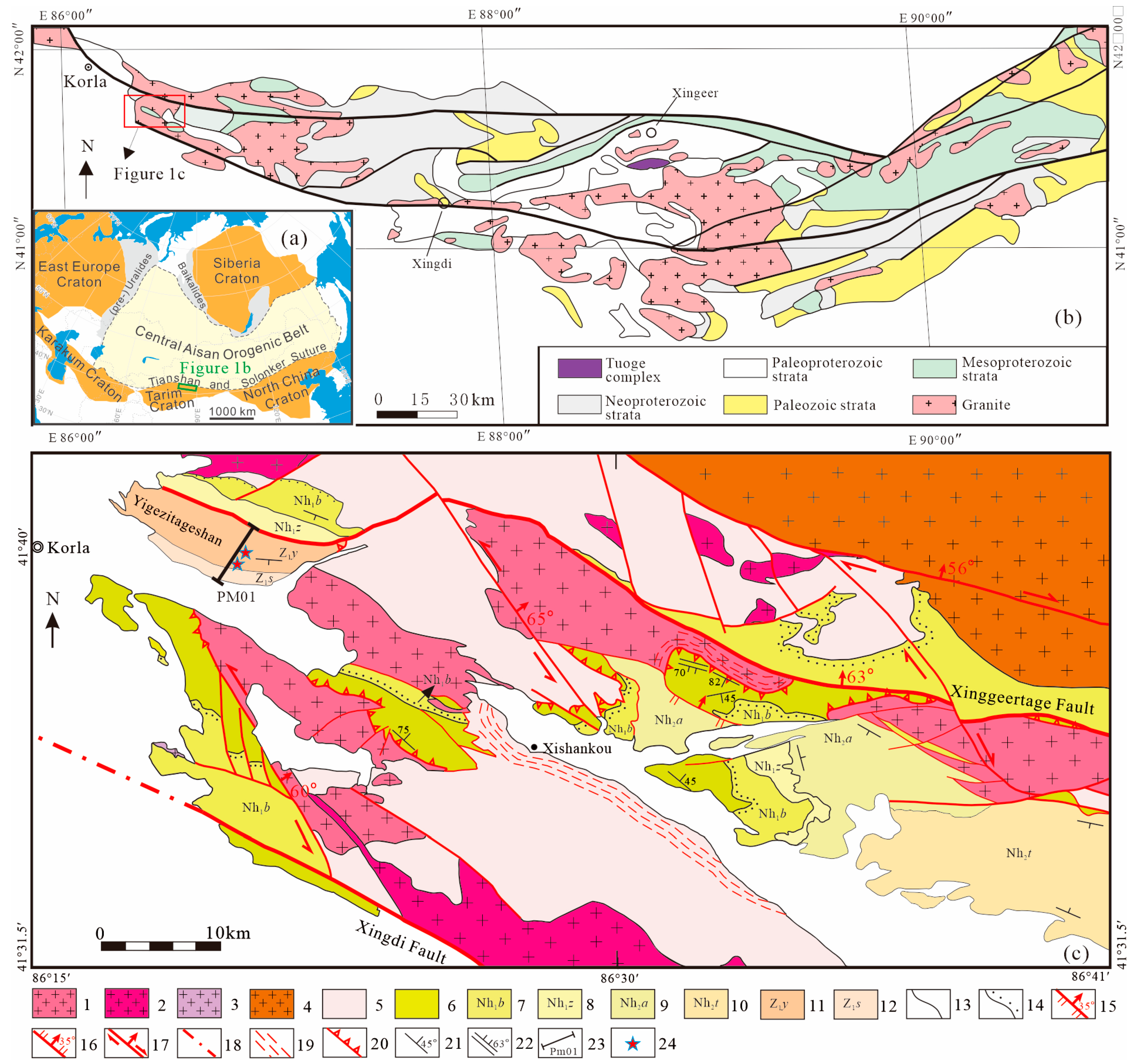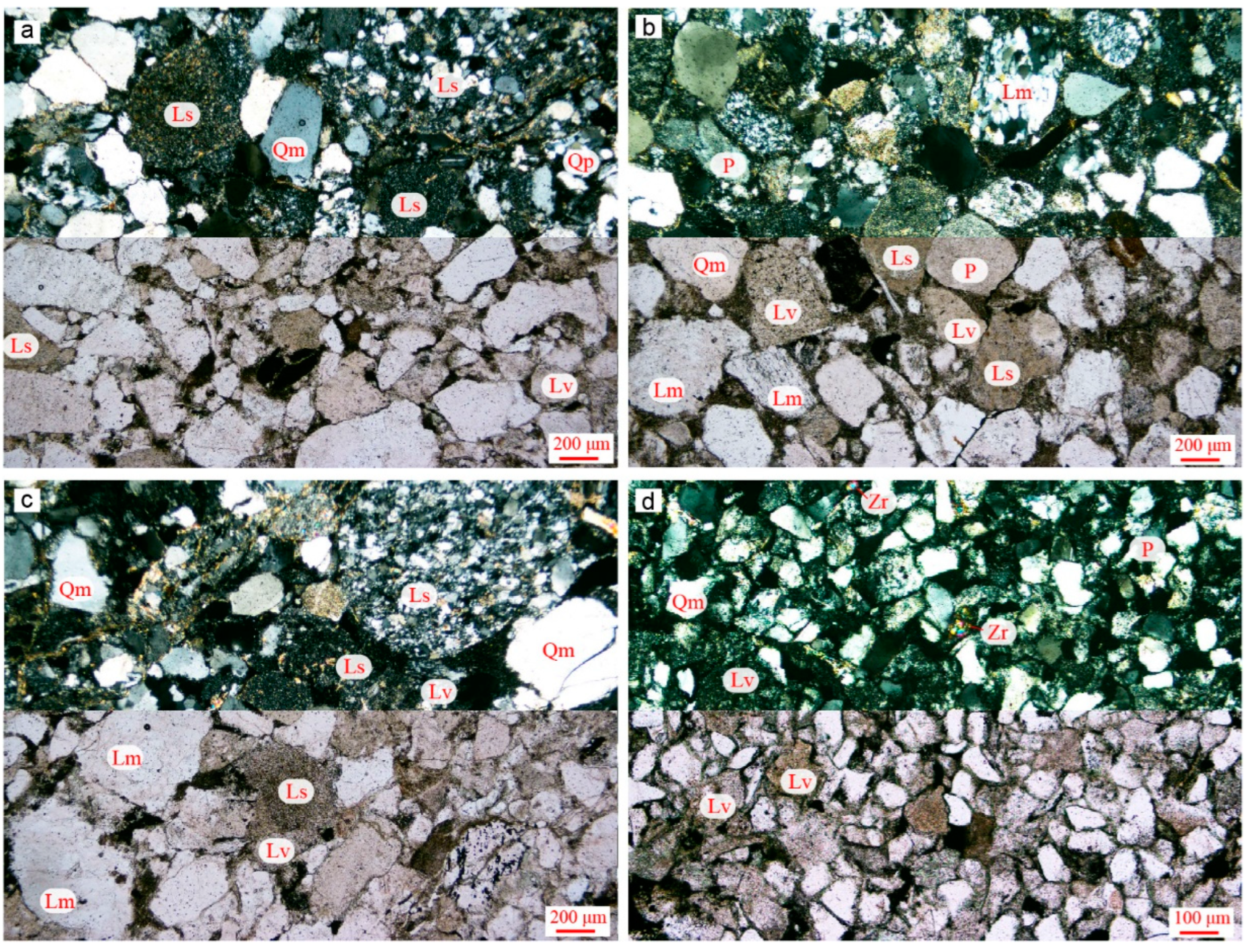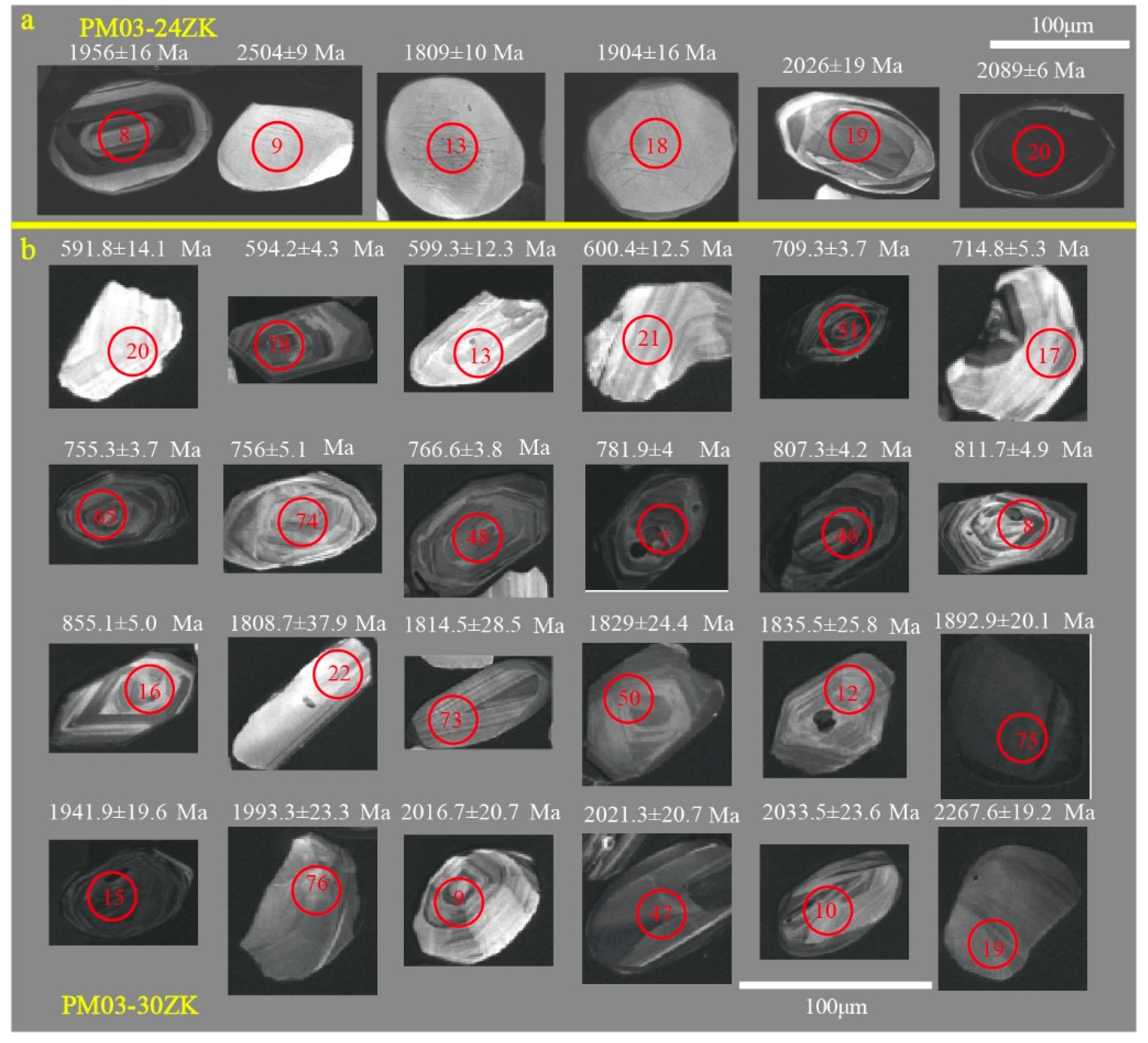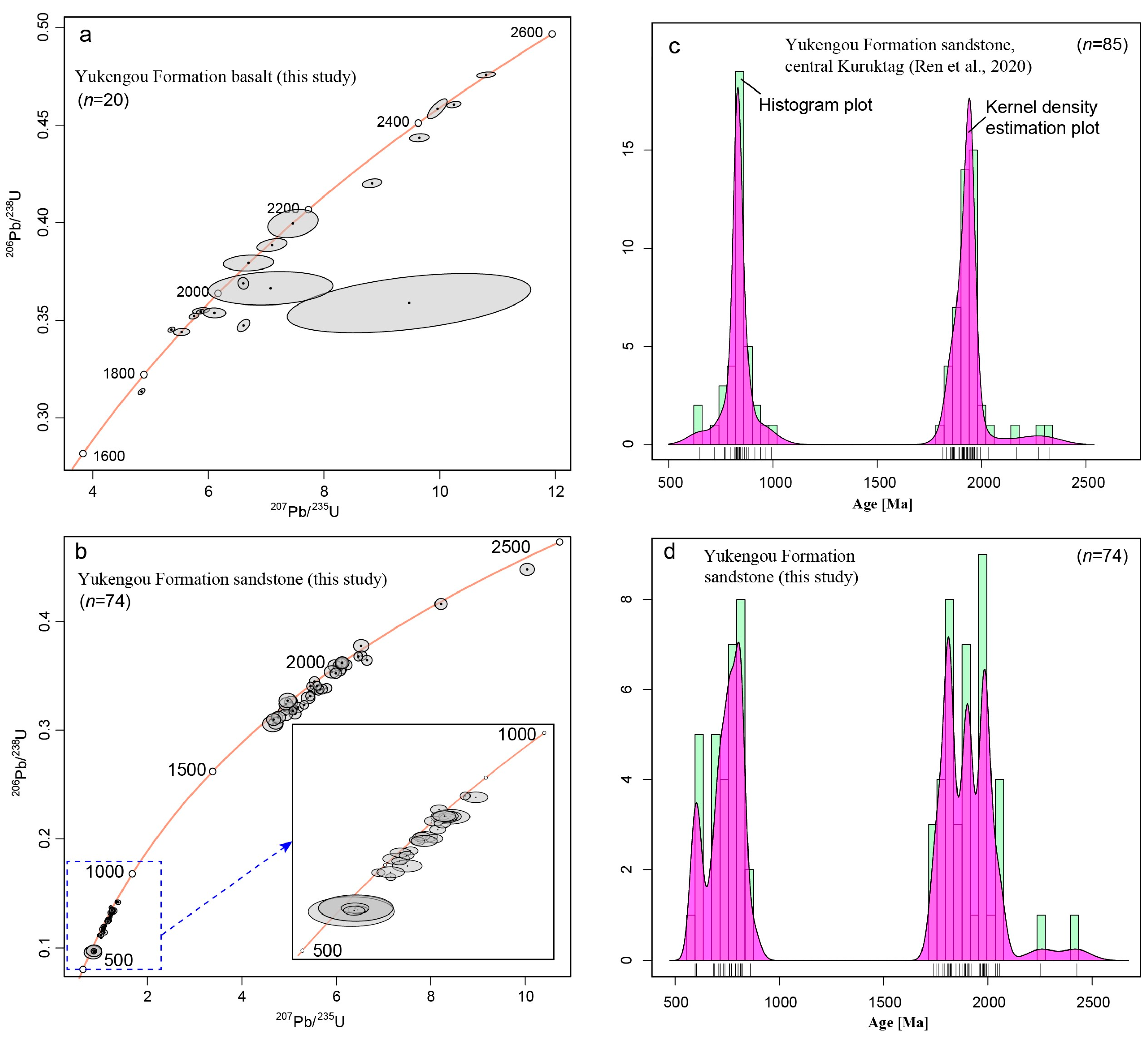First Identification of the Ediacaran Yukengou Formation in the Western Kuruktag Block, Northeastern Tarim, and Its Implications for Neoproterozoic Rift Basin Evolution
Abstract
1. Introduction
2. Geological Setting and Stratigraphic Characteristic
3. Sample Descriptions and Methods
3.1. Sample Descriptions
3.2. Sandstone Composition
3.3. Zircon U-Pb Geochronology
4. Results
4.1. Sandstone Composition
4.2. U-Pb Geochronology
4.2.1. Basalt Zircon U-Pb Dating Results
4.2.2. Sandstone Zircon U-Pb Dating Results
5. Discussion
5.1. Depositional Age and Attribution
5.2. Provenance
5.3. Geological Significance
6. Conclusions
- Clastic rocks characterized by the deltaic plain environment in the western Kuruktag block could be reassigned to the Yukengou Formation according to lithology correlation, maximum depositional age (596.5 ± 4.7 Ma), and paleontological evidence.
- The sandstones constituting the Yukengou Formation are chiefly composed of feldspathic litharenites, with the detritus derived from dissected magmatic arcs and orogenic wedges. Two main detrital zircon age populations, 1787–2010 Ma and 591–850 Ma, reveal that a substantial portion of the detritus was sourced from Paleoproterozoic and Neoproterozoic materials. In conjunction with the poor textural maturity of the sandstones, it is suggested that the provenance of the Yukengou Formation sandstones can be traced to the crystalline basement and Neoproterozoic magmatic events within the Kuruktag block itself.
- The lithic fragments and detrital zircon age compositions of the Yukengou Formation sandstones point towards deposition in a rift basin as opposed to a passive continental margin. The protracted continental rifting phase (740–596 Ma) in the Kuruktag area suggests that the Cryogenian–Ediacaran strata likely accumulated in an aulacogen basin. The presence of a substantial quantity of Neoproterozoic zircon grains indicates considerable volcanic activity preceding and during Cryogenian rifting, implying that continental rifting along the northeastern margin of Tarim may have been triggered by subduction-induced extension.
Supplementary Materials
Author Contributions
Funding
Data Availability Statement
Acknowledgments
Conflicts of Interest
References
- Xiao, S.; Bao, H.; Wang, H.; Kaufman, A.J.; Zhou, C.; Li, G.; Yuan, X.; Ling, H. The Neoproterozoic Quruqtagh Group in eastern Chinese Tianshan: Evidence for a post-Marinoan glaciation. Precambrian Res. 2004, 130, 1–26. [Google Scholar] [CrossRef]
- Duan, J.; Xia, D.; An, S. Deepwater sedimentation and sedimentotectono paleogeography of the NeoproterozoicEarly Palaeozoic aulacogen in Kuruktag, Xingjiang. China 2005, 79, 7, (In Chinese with English Abstract). [Google Scholar]
- Gao, L.Z.; Wang, Z.Q.; Xu, Z.Q.; Yang, J.S.; Zhang, W. A new evidence from zircon SHRIMP U-Pb dating of the Neoproterozoic diamictite in Quruqtagh area, Tarim basin, Xinjiang, China. Geol. Bull. China 2010, 29, 205–213, (In Chinese with English Abstract). [Google Scholar]
- Xu, B.; Jian, P.; Zheng, H.; Zou, H.; Zhang, L.; Liu, D. U–Pb zircon geochronology and geochemistry of Neoproterozoic volcanic rocks in the Tarim Block of northwest China: Implications for the breakup of Rodinia supercontinent and Neoproterozoic glaciations. Precambrian Res. 2005, 136, 107–123. [Google Scholar] [CrossRef]
- Li, Z.X.; Evans, D.A.D.; Halverson, G.P. Neoproterozoic glaciations in a revised global palaeogeography from the breakup of Rodinia to the assembly of Gondwanaland. Sediment. Geol. 2013, 294, 219–232. [Google Scholar] [CrossRef]
- Xu, B.; Xiao, S.; Zou, H.; Chen, Y.; Li, Z.; Song, B.; Liu, D.; Zhou, C.; Yuan, X. SHRIMP zircon U–Pb age constraints on Neoproterozoic Quruqtagh diamictites in NW China. Precambrian Res. 2009, 168, 247–258. [Google Scholar] [CrossRef]
- Zhang, C.L.; Ye, X.T.; Ernst, R.E.; Zhong, Y.; Zhang, J.; Li, H.K.; Long, X.P. Revisiting the Precambrian evolution of the Southwestern Tarim terrane: Implications for its role in Precambrian supercontinents. Precambrian Res. 2019, 324, 18–31. [Google Scholar] [CrossRef]
- Chen, H.; Chen, Y.; Ripley, E.M.; Li, C.; Deng, X.; Yue, S.; Zheng, Z.; Fu, B. Isotope and trace element studies of the Xingdi II mafic–ultramafic complex in the northern rim of the Tarim Craton: Evidence for emplacement in a Neoproterozoic subduction zone. Lithos 2017, 278–281, 274–284. [Google Scholar] [CrossRef]
- Wei, Z.; Guo, R.; Sun, M.; Lü, B.; Guo, Y.; Hu, X. The depositional environment and tectonic setting of Nanhuan Altungol Formation in the Quruqtagh area, northern margin of Tarim. Chin. J. Geol. 2017, 52, 58–78, (In Chinese with English Abstract). [Google Scholar]
- Wei, Z.; Guo, R.Q.; Sun, M.J.; Lü, B.; Jin, J.B.; Wang, H.P.; Wang, M.Y. Changes of detrital composition of sandstones from the Nanhua System, Quruqtagh area: Implications on their provenance and the evolution of basin. Acta Sedimentol. Sin. 2017, 35, 264–278, (In Chinese with English Abstract). [Google Scholar]
- Shen, W.; Zhu, X.; Xie, H.; Wang, X.; He, Y. Tectonic–sedimentary evolution during initiation of the Tarim Basin: Insights from late Neoproterozoic sedimentary records in the NW basin. Precambrian Res. 2022, 371, 106598. [Google Scholar] [CrossRef]
- Shi, K.; Liu, B.; Jiang, W.; Gao, X.; Liu, S.; Shen, Y. Sedimentary and evolutionary characteristics of Sinian in the Tarim Basin. Pet. Res. 2017, 2, 264–280. [Google Scholar] [CrossRef]
- Wu, H.X.; Zhang, F.Q.; Dilek, Y.; Chen, H.L.; Wang, C.Y.; Lin, X.-B.; Cheng, X.G.; Zhu, K.Y. Mid–Neoproterozoic collision of the Tarim Craton with the Yili–Central Tianshan Block towards the final assembly of Supercontinent Rodinia: A new model. Earth-Sci. Rev. 2022, 228, 103989. [Google Scholar] [CrossRef]
- Yi, Z.; Guo, Z.; Wei, G. A two-stage plume-induced rifting in the Neoproterozoic North Tarim: Evidence from detrital zircon study and seismic interpretation. Tectonophysics 2022, 838, 229503. [Google Scholar] [CrossRef]
- Ren, R.; Guan, S.-W.; Zhang, S.-C.; Wu, L.; Zhang, H.-Y. How did the peripheral subduction drive the Rodinia breakup: Constraints from the Neoproterozoic tectonic process in the northern Tarim Craton. Precambrian Res. 2020, 339, 105612. [Google Scholar] [CrossRef]
- Wu, L.; Guan, S.; Zhang, S.; Yang, H.; Jin, J.; Zhang, X.; Zhang, C. Neoproterozoic stratigraphic framework of the Tarim Craton in NW China: Implications for rift evolution. J. Asian Earth Sci. 2018, 158, 240–252. [Google Scholar] [CrossRef]
- Zhou, X.; Liu, W.; Wu, G.; Damian Nance, R.; Chen, Y.; Xiao, Y.; Yan, W.; Zhao, Y. The latest Neoproterozoic basaltic and siliciclastic rocks and tectonic implications in the Tarim Craton, NW China. J. Asian Earth Sci. 2022, 232, 105148. [Google Scholar] [CrossRef]
- Han, Y.; Zhao, G.; Sun, M.; Eizenhöfer, P.R.; Hou, W.; Zhang, X.; Liu, D.; Wang, B.; Zhang, G. Paleozoic accretionary orogenesis in the Paleo-Asian Ocean: Insights from detrital zircons from Silurian to Carboniferous strata at the northwestern margin of the Tarim Craton. Tectonics 2015, 34, 334–351. [Google Scholar] [CrossRef]
- Zhang, C.L.; Zou, H.B.; Li, H.K.; Wang, H.Y. Tectonic framework and evolution of the Tarim Block in NW China. Gondwana Res. 2013, 23, 1306–1315. [Google Scholar] [CrossRef]
- He, J.; Zhu, W.; Ge, R. New age constraints on Neoproterozoic diamicites in Kuruktag, NW China and Precambrian crustal evolution of the Tarim Craton. Precambrian Res. 2014, 241, 44–60. [Google Scholar] [CrossRef]
- Gao, Z.J. The Precambrian Geology in Northern Xinjiang. Number Sixth; Geological Publishing House: Beijing, China, 1993. (In Chinese) [Google Scholar]
- Gao, Z.J.; Lin, W.X.; Lu, S.N. Preliminary analysis of the sedimentary features of Qurugtagh Group in Qurugtagh area, Xinjiang region. Bull. Shenyang Inst. Geol. Min. Res. Chin. Acad. Geol. Sci. 1982, 15, 29. (In Chinese) [Google Scholar]
- XBGMR (Xinjiang Bureau of Geology and Mineralogy Resources). Stratigraphy of Xinjiang Uygur Autonomous Region; China University of Geosciences Press: Wuhan, China, 1999; pp. 2–19. (In Chinese) [Google Scholar]
- Lu, S.; Li, H.; Zhang, C.; Niu, G. Geological and geochronological evidence for the Precambrian evolution of the Tarim Craton and surrounding continental fragments. Precambrian Res. 2008, 160, 94–107. [Google Scholar] [CrossRef]
- Luo, Z.W.; Xu, B.; He, J.Y. U-Pb Detrital Zircon Age Constraints on the Neoproterozoic Tereeken Glaciation in the Quruqtagh Area, Northwestern China. Acta Sci. Nat. U Pekin. 2016, 52, 467–474, (In Chinese with English Abstract). [Google Scholar]
- Zhang, Y.; Wang, Z.; Yan, Z.; Wang, T. Neoproterozoic volcanic rocks in the southern Quruqtagh of northwest China: Geochemistry, zircon geochronology and tectonic implications. Acta Geol. Sin. Engl. Ed. 2013, 87, 118–130. [Google Scholar]
- Yang, E.L.; Wu, P.; Lü, X.B.; Wu, C.M.; Liu, W.; Chao, X.F. Dating of the basal Cambrian in the Kuruktag area of the Tarim craton: LA-ICP-MS zircon U-Pb age of tuffs. Acta Geol. Sin. 2021, 95, 3256–3265, (In Chinese with English Abstract). [Google Scholar]
- Zhu, H. Age Determination of Neoproterozoic in the Area of the Xinjiang Area; Jilin University: Changchun, China, 2018; (In Chinese with English Abstract). [Google Scholar]
- Li, C.H. The Qingbaikou System of Xingditag in Xinjiang, and Its Lower and Upper Boundaries. Xinjiang Geol. 1983, 1, 75–79, (In Chinese with English Abstract). [Google Scholar]
- Dickinson, W.R.; Suczek, C.A. Plate tectonics and sandstone compositions. Aapg Bull. 1979, 63, 2164–2182. [Google Scholar]
- Dickinson, W.R. Interpreting provenance relations from detrital modes of sandstones. Proven. Arenites 1985, 148, 333–361. [Google Scholar]
- Ingersoll, R.V.; Bullard, T.F.; Ford, R.L.; Grimm, J.P.; Pickle, J.D.; Sares, S.W. The effect of grain size on detrital modes: A test of the Gazzi-Dickinson point-counting method. J. Sediment. Res. 1984, 54, 103–116. [Google Scholar]
- Liu, Y.S.; Hu, Z.C.; Gao, S.; Gunther, D.; Xu, J.; Gao, C.G.; Chen, H.H. In situ analysis of major and trace elements of anhydrous minerals by LA-ICP-MS without applying an internal standard. Chem. Geol. 2008, 257, 34–43. [Google Scholar] [CrossRef]
- Andersen, T. Correction of common lead in U–Pb analyses that do not report 204 Pb. Chem. Geol. 2002, 192, 59–79. [Google Scholar] [CrossRef]
- Vermeesch, P.; Resentini, A.; Garzanti, E. An R package for statistical provenance analysis. Sediment. Geol. 2016, 336, 14–25. [Google Scholar] [CrossRef]
- Dickinson, W.R.; Gehrels, G.E. Use of U–Pb ages of detrital zircons to infer maximum depositional ages of strata: A test against a Colorado Plateau Mesozoic database. Earth Planet. Sci. Lett. 2009, 288, 115–125. [Google Scholar] [CrossRef]
- Folk, R.L. Petrology of Sedimentary Rocks; Hemphill Publishing Company: Austin, TX, USA, 1980. [Google Scholar]
- Ge, R.; Zhu, W.; Wilde, S.A.; He, J.; Cui, X. Synchronous crustal growth and reworking recorded in late Paleoproterozoic granitoids in the northern Tarim craton: In situ zircon U-Pb-Hf-O isotopic and geochemical constraints and tectonic implications. Geol. Soc. Am. Bull. 2015, 127, 781–803. [Google Scholar] [CrossRef]
- Ge, R.; Zhu, W.; Wu, H.; He, J.; Zheng, B. Zircon U–Pb ages and Lu–Hf isotopes of Paleoproterozoic metasedimentary rocks in the Korla Complex, NW China: Implications for metamorphic zircon formation and geological evolution of the Tarim Craton. Precambrian Res. 2013, 231, 1–18. [Google Scholar] [CrossRef]
- Guo, Y.; Zhao, G.; Guo, R.; Han, Y.; Liu, Q.; Wei, Z.; Zhou, N.; Ju, P.; Song, Z. Metamorphism and geochronology of garnet mica schists from the Kuluketage area: Implications for reconstructions of the Tarim Craton in supercontinent Columbia. Precambrian Res. 2022, 379, 106806. [Google Scholar] [CrossRef]
- Guo, Y.; Zhao, G.; Guo, R.; Han, Y.; Wei, Z.; Zhou, N.; Ju, P. Late Paleoproterozoic orogenic evolution of the northern Tarim Craton, NW China: Insights from phase equilibrium modeling and zircon U-Pb geochronology of metapelitic granulite in the Kuluketage area. Gondwana Res. 2022, 106, 351–366. [Google Scholar] [CrossRef]
- Sun, M.; Guo, R.; Palati, A. Metamorphism and U⁃ Pb dating of Al⁃ rich gneisses in Quruqtagh, Xinjiang. Xinjiang Geol. 2015, 33, 449, (In Chinese with English Abstract). [Google Scholar]
- Lei, R.; Wu, C.; Chi, G.; Chen, G.; Gu, L.; Jiang, Y. Petrogenesis of the Palaeoproterozoic Xishankou pluton, northern Tarim block, northwest China: Implications for assembly of the supercontinent Columbia. Int. Geol. Rev. 2012, 54, 1829–1842. [Google Scholar] [CrossRef]
- Long, X.; Yuan, C.; Sun, M.; Xiao, W.; Zhao, G.; Zhou, K.; Wang, Y.; Hu, A. The discovery of the oldest rocks in the Kuluketage area and its geological implications. Sci. China Earth Sci. 2011, 54, 342–348. [Google Scholar] [CrossRef]
- Shu, L.S.; Deng, X.L.; Zhu, W.B.; Ma, D.S.; Xiao, W.J. Precambrian tectonic evolution of the Tarim Block, NW China: New geochronological insights from the Quruqtagh domain. J. Asian Earth Sci. 2011, 42, 774–790. [Google Scholar] [CrossRef]
- Zhang, C.L.; Li, H.K.; Santosh, M.; Li, Z.X.; Zou, H.B.; Wang, H.; Ye, H. Precambrian evolution and cratonization of the Tarim Block, NW China: Petrology, geochemistry, Nd-isotopes and U–Pb zircon geochronology from Archaean gabbro-TTG–potassic granite suite and Paleoproterozoic metamorphic belt. J. Asian Earth Sci. 2012, 47, 5–20. [Google Scholar] [CrossRef]
- Lü, B. Geochronology and Petrogenesis of Neoproterozoic Granitoid in Quruqtagh, Xinjiang; Xinjiang University: Xinjiang, China, 2017; (In Chinese with English Abstract). [Google Scholar]
- Ge, R.; Zhu, W.; Wilde, S.A. Mid-Neoproterozoic (ca. 830-800 Ma) metamorphicP-Tpaths link Tarim to the circum-Rodinia subduction-accretion system. Tectonics 2016, 35, 1465–1488. [Google Scholar] [CrossRef]
- Ge, R.; Zhu, W.; Zheng, B.; Wu, H.; He, J.; Zhu, X. Early Pan-African magmatism in the Tarim Craton: Insights from zircon U–Pb–Lu–Hf isotope and geochemistry of granitoids in the Korla area, NW China. Precambrian Res. 2012, 212–213, 117–138. [Google Scholar] [CrossRef]
- Zhang, C.; Li, X.; Li, Z.; Lu, S.; Ye, H.; Li, H. Neoproterozoic ultramafic–mafic-carbonatite complex and granitoids in Quruqtagh of northeastern Tarim Block, western China: Geochronology, geochemistry and tectonic implications. Precambrian Res. 2007, 152, 149–169. [Google Scholar] [CrossRef]
- Zhang, C.L.; Li, Z.X.; Li, X.H.; Ye, H.M. Neoproterozoic mafic dyke swarms at the northern margin of the Tarim Block, NW China: Age, geochemistry, petrogenesis and tectonic implications. J. Asian Earth Sci. 2009, 35, 167–179. [Google Scholar] [CrossRef]
- Zhang, C.L.; Yang, D.S.; Wang, H.Y.; Takahashi, Y.; Ye, H.M. Neoproterozoic mafic-ultramafic layered intrusion in Quruqtagh of northeastern Tarim Block, NW China: Two phases of mafic igneous activity with different mantle sources. Gondwana Res. 2011, 19, 177–190. [Google Scholar] [CrossRef]
- Wang, H.; Guo, R.; Zhu, Z.; Jin, J.; Wang, M.; Wei, Z.; Lü, B. Genesis and geological significances of Nanhua granitic volcanic-intrusive complexes in Quruqtagh on the northern margin of the Tarim block, China. Chin. J. Geol. 2016, 51, 239–261, (In Chinese with English Abstract). [Google Scholar]
- Zhang, C.L.; Ye, X.T.; Li, H.K. The latest Neoproterozoic igneous activity on the northern margin of the Tarim Craton. Geol. Bull. China 2014, 33, 606–613, (In Chinese with English Abstract). [Google Scholar]
- Zhao, P.; Chen, Y.; Zhan, S.; Xu, B.; Faure, M. The Apparent Polar Wander Path of the Tarim block (NW China) since the Neoproterozoic and its implications for a long-term Tarim–Australia connection. Precambrian Res. 2014, 242, 39–57. [Google Scholar] [CrossRef]
- Zhang, Y.; Wang, Z.; Yan, Z.; Wang, T. Tectonic setting of Neoproterozoic Beiyixi Formation in Quruqtagh area, Xinjiang: Evidence from geochemistry of clastic rocks. Acta Petrol. Sin. 2011, 27, 1785–1796, (In Chinese with English Abstract). [Google Scholar]
- Zhang, Y.; Wang, Z.; Yan, Z.; Wang, T.; Guo, X. Provenance of Neoproterozoic rocks in Quruqtagh area, Xinjiang: Evidence from detrital zircon geochronology. Acta Petrol. Sin. 2011, 27, 121–132, (In Chinese with English Abstract). [Google Scholar]
- Sun, J.; He, J.; Tao, X.; Guo, S.; Pan, X.; Zhao, K.; Zhang, H.; Yuan, J. Stratigraphic correlation and sedimentology of the Ediacaran succession in the Tarim Basin, NW China: Implications for paleogeographic reconstruction and hydrocarbon exploration. J. Asian Earth Sci. 2023, 247, 105607. [Google Scholar] [CrossRef]
- Garzanti, E. The Himalayan Foreland Basin from collision onset to the present: A sedimentary–petrology perspective. Geol. Soc. Lond. Spec. Publ. 2019, 483, 65–122. [Google Scholar] [CrossRef]
- Garzanti, E.; Doglioni, C.; Vezzoli, G.; Ando, S. Orogenic belts and orogenic sediment provenance. J. Geol. 2007, 115, 315–334. [Google Scholar] [CrossRef]
- Garzanti, E.; Vermeesch, P.; Padoan, M.; Resentini, A.; Vezzoli, G.; Andò, S. Provenance of Passive-Margin Sand (Southern Africa). J. Geol. 2014, 122, 17–42. [Google Scholar] [CrossRef]
- Zhang, B.S.; Wei, Y.S.; Garzanti, E.; Wang, C.S.; Chen, X.; Pan, W.Y.; Liu, Q.S. Sedimentologic and stratigraphic constraints on the orientation of the Late Triassic northern Indian passive continental margin. Palaeogeogr. Palaeoclimatol. Palaeoecol. 2019, 533, 109234. [Google Scholar] [CrossRef]
- Cawood, P.A.; Hawkesworth, C.J.; Dhuime, B. Detrital zircon record and tectonic setting. Geology 2012, 40, 875–878. [Google Scholar] [CrossRef]
- Hu, X.M.; Garzanti, E.; Wang, J.G.; Huang, W.T.; An, W.; Webb, A.A.G. The timing of India-Asia collision onset—Facts, theories, controversies. Earth-Sci. Rev. 2016, 160, 264–299. [Google Scholar] [CrossRef]
- Zheng, B.H.; Zhu, W.B.; Ge, R.F.; Wu, H.L.; He, J.W.; Lu, Y.Z. Proterozoic tectonic evolution of the Tarim Craton: New insights from detrital zircon U-Pb and Lu-Hf isotopes of metasediments in the Kuruktag area. Precambrian Res. 2020, 346, 105788. [Google Scholar] [CrossRef]
- Wei, Z.; Li, X.; Li, Y.; Fan, X.; Wang, J.; Zhang, C.; Jiebu, G. Discovery of Vestige Sedimentary Archives of the India-Asia Collision in the Eastern Yarlung Zangbo Suture Zone. J. Geophys. Res. Solid Earth 2020, 125, e2019JB018192. [Google Scholar] [CrossRef]
- Korsch, R.; Adams, C.; Black, L.; Foster, D.; Fraser, G.; Murray, C.; Foudoulis, C.; Griffin, W. Geochronology and provenance of the Late Paleozoic accretionary wedge and Gympie Terrane, New England Orogen, eastern Australia∗. Aust. J. Earth Sci. 2009, 56, 655–685. [Google Scholar] [CrossRef]
- Cawood, P.; Nemchin, A. Provenance record of a rift basin: U/Pb ages of detrital zircons from the Perth Basin, Western Australia. Sediment. Geol. 2000, 134, 209–234. [Google Scholar] [CrossRef]
- Keller, G.R.; Stephenson, R.A. The Southern Oklahoma and Dniepr-Donets aulacogens: A comparative analysis. In 4-D Framework of Continental Crust; Geological Society of America Memoirs: Boulder, CO, USA, 2007; pp. 127–143. [Google Scholar]
- Khudoley, A.; Rainbird, R.; Stern, R.; Kropachev, A.; Heaman, L.; Zanin, A.; Podkovyrov, V.; Belova, V.; Sukhorukov, V. Sedimentary evolution of the Riphean–Vendian basin of southeastern Siberia. Precambrian Res. 2001, 111, 129–163. [Google Scholar] [CrossRef]
- Stein, S.; Stein, C.A.; Elling, R.; Kley, J.; Keller, G.R.; Wysession, M.; Rooney, T.; Frederiksen, A.; Moucha, R. Insights from North America’s failed Midcontinent Rift into the evolution of continental rifts and passive continental margins. Tectonophysics 2018, 744, 403–421. [Google Scholar] [CrossRef]
- Ren, R.; Guan, S.; Wu, L.; Zhu, G. Evolution of the Neoproterozoic rift basins and its implication for oil and gas exploration in the Tarim Basin. Pet. Res. 2018, 3, 66–76. [Google Scholar] [CrossRef]







Disclaimer/Publisher’s Note: The statements, opinions and data contained in all publications are solely those of the individual author(s) and contributor(s) and not of MDPI and/or the editor(s). MDPI and/or the editor(s) disclaim responsibility for any injury to people or property resulting from any ideas, methods, instructions or products referred to in the content. |
© 2023 by the authors. Licensee MDPI, Basel, Switzerland. This article is an open access article distributed under the terms and conditions of the Creative Commons Attribution (CC BY) license (https://creativecommons.org/licenses/by/4.0/).
Share and Cite
Sun, M.; Wei, Z.; Guo, R.; Liu, G.; Shi, M.; Cheng, Y. First Identification of the Ediacaran Yukengou Formation in the Western Kuruktag Block, Northeastern Tarim, and Its Implications for Neoproterozoic Rift Basin Evolution. Minerals 2023, 13, 914. https://doi.org/10.3390/min13070914
Sun M, Wei Z, Guo R, Liu G, Shi M, Cheng Y. First Identification of the Ediacaran Yukengou Formation in the Western Kuruktag Block, Northeastern Tarim, and Its Implications for Neoproterozoic Rift Basin Evolution. Minerals. 2023; 13(7):914. https://doi.org/10.3390/min13070914
Chicago/Turabian StyleSun, Minjia, Zhen Wei, Ruiqing Guo, Guiping Liu, Mingming Shi, and Yuanfeng Cheng. 2023. "First Identification of the Ediacaran Yukengou Formation in the Western Kuruktag Block, Northeastern Tarim, and Its Implications for Neoproterozoic Rift Basin Evolution" Minerals 13, no. 7: 914. https://doi.org/10.3390/min13070914
APA StyleSun, M., Wei, Z., Guo, R., Liu, G., Shi, M., & Cheng, Y. (2023). First Identification of the Ediacaran Yukengou Formation in the Western Kuruktag Block, Northeastern Tarim, and Its Implications for Neoproterozoic Rift Basin Evolution. Minerals, 13(7), 914. https://doi.org/10.3390/min13070914




